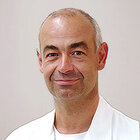Vascular Surgery
Vascular surgery is the medical speciality which covers interventions aimed at treating arterial, venous and lymphatic diseases. Arterial segments that may be subjected to vascular surgery include the carotid arteries, the thoracic and abdominal aorta or the arteries of the upper and lower limbs.
In cases of arteriosclerosis, which is a degeneration of the arterial wall due to high blood pressure, smoking, diabetes or high cholesterol levels, constrictions or obstructions of the blood vessels can be observed. There is then no longer enough blood being supplied to the organs, which can cause functional failure, pain or even sometimes gangrene (wounds). The aim of treatment is to restore enough blood flow to supply the organs with oxygen and nutrients.
A vascular surgeon can restore perfusion either by dilating the diseased segment, or by reconstructing the arterial axis using a bypass. The first method, which is known as the ‘endovascular’ method, involves dilating the artery using a balloon that is inserted through the skin and artery. A stent (a kind of tubular metallic spring) can then be placed inside the affected vessel in order to keep it open. Thanks to this technique, post-operative pain and risks of infection are greatly reduced. The patient can quickly return to a normal life.
When it is not possible to carry out an endovascular intervention, the patient will be offered an arterial bypass operation, during which a new arterial route is constructed, bypassing the obstruction of the blocked artery. In most cases, one of the patient’s veins will be used to create the bypass. But it is also possible to use synthetic or biological prostheses, of which many models are available on the market. A bypass operation puts more of a burden on the patient, but long-term results are excellent.
Another common disease of the arteries occurs when they are dilated and form an aneurysm. Unlike arteriosclerosis, an aneurysm does not usually produce any symptoms, as the blood flow remains unrestricted. However, it does put the patient at risk of a rupture or haemorrhage, and requires close monitoring, and sometimes a surgical intervention. The vascular surgeon will recommend the most appropriate treatment depending on the location and diameter of the aneurysm, be it the insertion of an endoprosthesis (covered stent) or a bypass.
The treatment of varicose veins also involves various vascular surgery techniques.
The range of activities of the vascular surgeons at Valais Hospital is not restricted to this set of examples. They also carry out the insertion of vascular access devices (fistula and catheters) for dialysis and the insertion of spinal cord nerve stimulators. These stimulators send out electrical impulses which improve arterial perfusion. They are inserted when the arteries are too damaged and no other operation is possible.
Of our specialist doctors, some work for the Centre Hospitalier Universitaire Vaudois (CHUV) and thus benefit from close cooperation in the fields of new medical and interventional technologies. Valais Hospital is one of the few centres in Switzerland which offers the full range of modern treatments connected to vascular surgery.
Organisation
-
Centre Hospitalier du Valais Romand
Sion
Av. Grand-Champsec 80, 1951 Sion +41(0)27 603 41 24 chvr.chirurgie.vasculaire@hopitalvs.ch -
Spitalzentrum Oberwallis
Spitalzentrum Oberwallis (Visp)
Pflanzettastrasse 8, 3930 Viège +41(0)27 604 21 71 sekretariat.chirurgie@hopitalvs.ch


